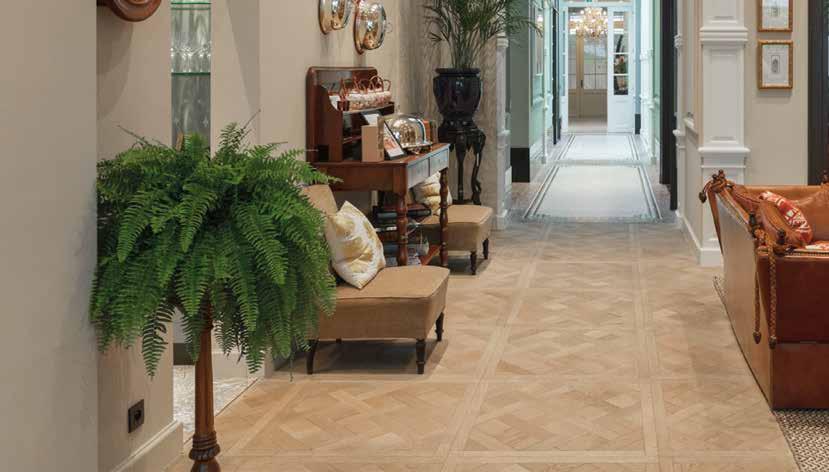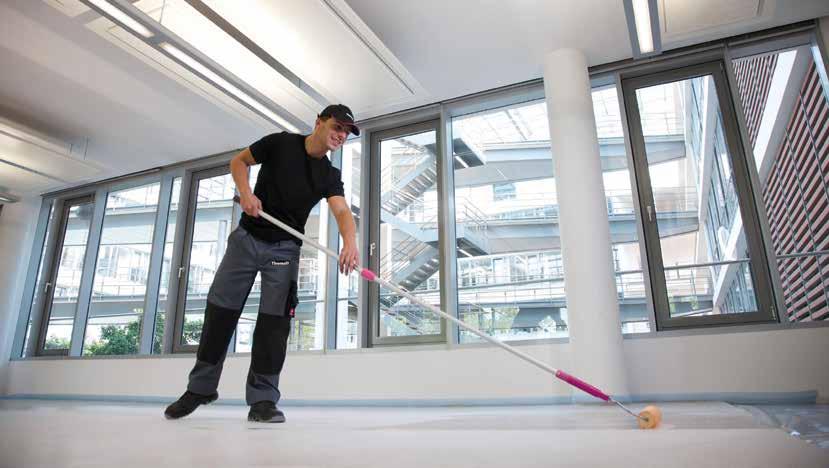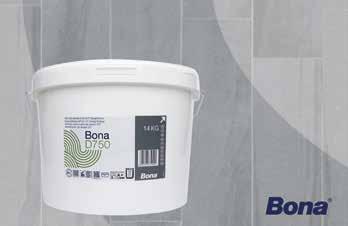
9 minute read
Special How do I mix colours and apply them?
THERE’S NO NEED TO BE WARY
MAKERS HAVE BEEN REFINING THE APPLICATION FOR MANY YEARS
Advertisement
Photo – Plastor
There are very few aspects of the parquet floor fitting profession which require more expertise than mixing and applying colours. After all, this is a work of precision where professionals have to take exceptional care. However, contrary to what many people think, it’s not really necessary to be wary of mixing and applying colours.
We called upon Blanchon, which is a specialist in this field and, amongst other things, covers this part of the trade amply during their Technical Days. They reassured us even before we could finish our first question: ‘No, there’s no need for parquet floor fitters to be wary of applying colours.’
They told us: ‘First and foremost, that’s because the various makers, ourselves included, have worked hard for many years to make the job easier and improve results. Nowadays, professionals generally agree that it’s a lot easier and safer to apply a water-based stain (which mainly contains lightfast pigments and not the sometimes unstable colouring agents) than it was 20 years ago. Two decades ago, you had a stain based on alcohol or ‘petrol’ (in reality petroleum solvents) which dried almost at once. That made it extremely difficult to apply these products in rooms bigger than 15m²!’
‘Moreover, a finish which is designed to give a parquet floor a new look and/or feel for the benefit of both potential clients and financial gain is not considered to be on the same level as a ‘classic’ colourless glaze. And so, it provides added value in every respect for specialist parquet floor fitters to present a range of shades.’
The preparation of the wood
We’ll start at the beginning: What about the preparation of the wood before you colour it? ‘There are various technical options for colouring a floor. You can use a stain, a colour, a distressing agent (sometimes called a staining agent or positive stain), or a colour oil. The use of the latter is very popular because this gives the floor both colour and a finish in one operation.’ ‘In fact, the deployed procedure is exactly the same with new or old parquet. There are no special requirements, except obviously that the wood has to be prepared in line with professional standards and that the standard safeguards should be applied as regards moisture
content, temperature, and any ventilation; with the latter, you have to be particularly wary of excessively powerful air conditioning systems which could involuntarily speed up the drying process.’
Quality of the preparation
Our interviewee points out that it is absolutely essential never to lose sight of the quality of the preparation. Those with a good knowledge of the work realise immediately that sandpapering is necessary. He says: ‘For a stain, a colour, or a distressing agent you have to use a fine finish (120 grain). If there are still some sanding marks, the added extra colour will cause streaks to spoil the end result. For a colour oil it is essential that the pores of the wood are sufficiently open for maximum impregnation to saturate the fibres and maximise the shade. A finish with 100 grain (sometimes 80 grain) is then recommended. In particular, don’t forget that it will be necessary to remove all dust carefully before you apply the colouring agent.’
Offering the classics
What we also want to know is how a specialist like Blanchon decides which colours to include in its range. How do they justify that with respect to floor fitters? ‘In terms of wood shades professionals should always assume that they have to offer “the major classics”. In that regard you should refer to tradition. To be specific, we’re talking here about various shades of oak, the light orange of cherry wood, the dark orange of jatoba, and various popular shades for exotic wood sorts, such as merbau, ipe, or padauk, and also the very dark shades of ebony or wenge.’
‘In turn, grey shades are designed more to refer to elements such as “driftwood”. They are applied either directly or by print. Then, for instance, it’s about the use of a dark or medium-grey distressing agent, followed by an oil in a light shade of grey. The diverse shades of white are always in demand, especially if the floor can be brushed before the application. Bright colours, which had disappeared completely from the range, are now back in small details, whereby they make the showrooms more vivid. Should you expect extra sales from those bright colours? No, sadly, hardly at all, but they do make it more likely that people will visit your showroom. That’s a nice bonus for professionals who want to show which systems they can apply.’
An overview
Blanchon

Blanchon has two ranges of wood stains which are the most important products in the assortment. They offer them for use and application on site by floor fitters in two forms. One range is mono-component and based on a colouring agent, whilst the other one is dual-component and based on a pigment. With the latter, both users and end clients will notice the excellent colour depth and remarkable resistance to UV. In addition, they also sell a range of distressing agents on the market. With these distressing agents we must note that they are reactive stains with a positive effect. These three series have no more than a decorative purpose. After the finish (obviously, we mean the decoration), they have to be covered with a glazer. That glazer will usually be ultra matt or invisible. What is also possible is the use of an oil, which may or may not have a shade of colour and which, in turn, can contribute to the required end finish.
Bona

Bona oils can be combined using a clear and simple process and adapted as required to create an infinite number of colours and effects which blend seamlessly in any setting. This gives flexibility to highlight the natural character of the wood and create simply fantastic new looks. The parquet oil Bona Craft Oil 2K comes in 19 standard colours which can easily be mixed with each other. By moistening the surface lightly (‘water-popping’), you get another shade of colour. By using 2 Bona Tones, Bona Nordic Tone, and Bona Rich Tone, you can extend the range of colours even more. These Tones should be finished with Bona Craft Oil. If you want to intensify the colours, you have the option of adding Bona Mix Colour (a concentrated pigment paste) to Bona Nordic Tone or Bona Rich Tone. Bona Mix Colour reinforces or modifies the colour of these Tones to create special effects. The surface should always be finished afterwards with Bona Craft Oil. If you want to give the oiled floor some extra protection, you can apply some lacquer to Bona Craft Oil 2K using the parquet lacquer Bona Traffic HD. This is definitely beneficial for high-traffic surfaces such as those in commercial zones.
Chimiver
LIOS BIOIL Colorato is a colored natural oil treatment for wooden floors with easy application, very durable and soft effect on the surface. LIOS BIOIL Colorato is available in 20 different colors, miscible together to make a wide range of new colors.
Pallmann

With the PALLMANN COLOR COLLECTION PALLMANN provides a range of 24 coloured oil primers. Each color consists of 3 components: The 2K oil primer PALL-X 333 A / B is given a color C concentrate as a third and final component: This combination is suitable for the priming and simultaneous colouring of many commercial wood types, especially oak, ash, pine on site. The surface can then be protected with the 2 component water-based wood floor coatings PALL-X 98, PALL-X ZERO 2K, PALL-X PURE as well as with the 2-component wood floor oil MAGIC OIL 2K ORIGINAL. We provide special trainings for the individualisation and for the coloring of wood floors for our customers as well as a huge package of marketing and sales support e.g. color tester to see the color result on the wood chosen by the end customer.
Plastor

The colours in COLOUR FLOORS TINT PLASTOR can only be applied to untreated wood for maximum penetration into the wood. If the wood is extremely slippery and the pores aren’t open, it’s advisable to sandpaper with grain 120 before applying a colour. You can then choose your colour in accordance with the desired look. Take care! Some wood sorts have their limits: Wood sorts which contain a lot of tannic acid (oak, chestnut, exotic wood, cherry wood, etc.) do not allow you to apply a water-based white (or very light) shade directly. Tannic acid cannot be mixed with water and will cause the colour to turn yellow as it dries. If you do opt for a white shade for these specific sorts, it is advisable to apply a solvent finish product instead (such as DECOPROTECT white hard wax oil). PLASTOR certainly also offers shaded finishes with its DECOPROTECT hard wax oil (nine colours). For COLOUR FLOORS TINT it is necessary to consider various factors, such as the application at a maximum temperature of 12 to 25°C with no breeze. It is also advisable to work in areas of 2/3m² and to apply the colour with a spatula along the skirting boards and then with a lacquer roller. Wipe the shade with a cloth soon after the application. A shade only gives the wood colour, so it is necessary to protect it (primer + varnish or oil). If the water-based finish product is like the colour and you don’t apply a universal solvent primer (PRIM'SO), you will have to wait 24 hours until the colour is dry in order to obtain a good result.
RIGO Verffabriek
ROYL-OIL/SKYLT Undercoat Oil 2K
The ROYL-OIL (2K) from RIGO Verffabriek penetrates deep into the pores of the wood and gives the wood a matt natural look. The oil can also include colour pigments so that the floor can be coloured and protected in a single process. The finish is so strong that a single layer is sufficient. RIGO Verffabriek displays the standard colours in two colour swatches with a letter/number combination. The letter refers to the base, the number to the colour pigment (W10 Livid = base White + colour pigment 10). The ROYL Wood Tone Range features 24 colours from Basis Clear. The ROYL Greyscale Range contains 18 colours from Basis Clear, White, or Black. As the bases and colour pigments can be blended with one another, the colour possibilities are endless. The most popular colours are also available ready-mixed in a half-litre container. Convenient for furniture craftsmen and interior designers. Would you like the appearance of an oil floor, but with the power of a varnish? Use SKYLT Undercoat Oil 2K. The colour options are identical to the ROYL-OIL line. SKYLT Undercoat Oil can be varnished directly with SKYLT after it has been wiped dry. As SKYLT varnish is truly invisible, the wood retains its natural appearance. You’re free to vary with colour shades thanks to SKYLT Undercoat Oil 2Kl. Floors are easy to maintain after being finished with SKYLT.









